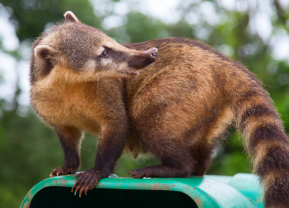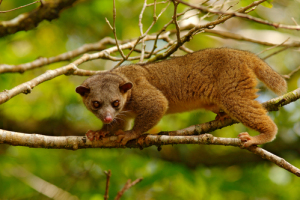The Procyonids are all the mammals classified in the Carnivoran family of Procyonidae. This family includes Raccoons, Olingos, the Cacomistle, Coatis, the Kinkajou, and the Ringtail. With the exception of North America’s Common Raccoon, most Procyonids are found in Central and South America. The Red Panda(Ailurus fulgens) is a mammal that was once thought to be a Procyonid but is now the only species classified in the Ailuridae family. The Giant Panda was also classified as a Procyonid in the past but is now classified in the Ursidae family(Bears). Even though Procyonids are classified in the Carnivora order, they are all omnivorous, and feed on fruits, insects, and small vertebrates. All Procyonids are tree climbers, and the Kinkajou is almost entirely arboreal.
Physical Characteristics
Many species of Procyonids have facial markings and a dark-banded tail. The feet have five digits and are void of fur on the soles. Their Long fingers give them really good dexterity. The tail can be prehensile, as in the Kinkajou, or semiprehensile and used for balance as in the Coatis. The claws are short, curved, and either nonretractile or semiretractile. all species are good climbers, and at least one species, the kinkajou, is almost entirely arboreal. Procyonids are 30 centimeters to 1.1 meters in length and weigh between 800 grams to 14 kilograms.
Habitat and Distribution
Procyonids live in the Americas, where they inhabit forests, brushland, rocky areas, and shrubland.
Breeding
After a gestation period of 54 to 77 days procyonids give birth to litters of one 1 to 7 offspring.
Diet
Procyonids are omnivores and eat crustaceans, frogs, fish, nuts, seeds, fruits, insects, small mammals, worms, birds, and lizards.
Species

Common Raccoon(Procyon lotor). The Common Raccoon is probably one of the most recognized and iconic species in the Procyonidae family. They can be found in much of North America where they live in their natural habitat of forests. Common Raccoons are very adaptable and can often be found living in urban areas where they are unfortunately considered pests by many homeowners. They weigh up to 14 kg, and the average body length is 67 cm.
Crab-Eating Raccoon(Procyon cancrivorus).The Crab-Eating Raccoon lives in jungle areas of Central and South America. As its name suggests its diet consists of many types of crustaceans but it will also eat fish, frogs, fruits, seeds, turtle eggs, and worms. Crab-Eating Raccoons weigh up to 12 kg, and are 67 cm in length on average.
Cozumel Raccoon(Procyon pygmaeus).This species lives only on the Cozumel Island which is off Mexico’s Yucatan Peninsula. They weigh 3 to 4 kg.
Northern Olingo(Bassaricyon Gabbii).The Northern Olingo is also known as the Bushy-Tailed Olingo or simply as the Olingo(due to it being the most commonly seen of the species). They live in Central America to Northern South America. The body weight is up to 1.5 kilograms, and the length is 40 centimeters on average.
Eastern Lowland Olingo(Bassaricyon Alleni). The Eastern Lowland Olingo is also known as the Allen’s Olingo because its scientific species name honors American zoologist Joel Asaph Allen. Allen is who first described the genus Bassaricyon. This species lives in Bolivia, Brazil, Colombia, Ecuador, Guyana, Peru, and Venezuela. This species weighs up to 1.6 kg, and is 41 centimeters long on average.
Western Lowland Olingo(Bassaricyon medius). The Western Lowland Olingo can be found in the countries of Panama, Colombia, and Ecuador. Western Lowland Olingos weigh up to 1.2 kilograms and are about 36 centimeters in length.
Olinguito(Bassaricyon neblina). The Olinguito lives in montane forests in the Andes of western Colombia and Ecuador. The species name neblina is Spanish for fog or mist, referring to the cloud forest habitat of the olinguito. The body weight is 900 grams on average.
Ringtail(Bassariscus astutus). The ringtail is found from the western United States to southern Mexico. Ringtails weigh up to 1.4 kilograms, and are 36 centimeters in length on average.
Cacomistle(Bassariscus sumichrasti). Cacomistles live from southern Mexico to Panama where they inhabit forested and rocky areas. Cacomistles weight up to 1.3 kilograms and are 39 centimeters in length on average.

South American Coati (Nasua nasua), The South American Coati is also known as the Ring-Tailed Coati and can be found from southern Mexico to Panama. The South American Coati weighs up to 7.2 kilograms.
White-Nosed Coati(Nasua narica), The White-Nosed Coati is also known as the Coatimundi. The White-Nosed Coati is distributed from southeastern Arizona and New Mexico through Mexico and Central America; in Colombia, it is limited to the far northwestern region near the border with Panama. The White-Nosed Coati weighs up to 6 kilograms and is about 1 meter in length.
Western Mountain Coati(Nasuella olivacea). Western Mountain Coatis live in northern South America where they inhabit tropical forests on the slopes of the andes Mountains. They weigh up to 2 kilograms, and are about 40 centimeters in length.
Eastern Mountain Coati(Nasuella meridensis). The eastern mountain coati is found in cloud forest in the Andes of western Venezuela.

Kinkajou(Potos flavus). Kinkajous are found from Mexico to central Brazil. Kinkajous are almost completely arboreal. They weigh up to 4.6 kilograms, and are 83 centimeters in length on average.
Fun Facts
- The Common Raccoon is well known for its “bandit” mask.
- In the 1980s the Canadian Broadcasting Corporation aired an animated program titled “The Raccoons”, it showed the adventures of Bert Raccoon and his roomates, Ralph and Lisa Raccoon. It aired on CBC from November 11, 1985 until March 19, 1991. This series was also broadcasted in the United States on The Disney Channel from July 4, 1985 to August 28, 1992.
- Rocket Raccoon is a fictional character appearing in American comic books published by Marvel Comics.
- The Common Raccoon has quite a reputation for being a robber of gardens, campsites, cabins, and garbage.
